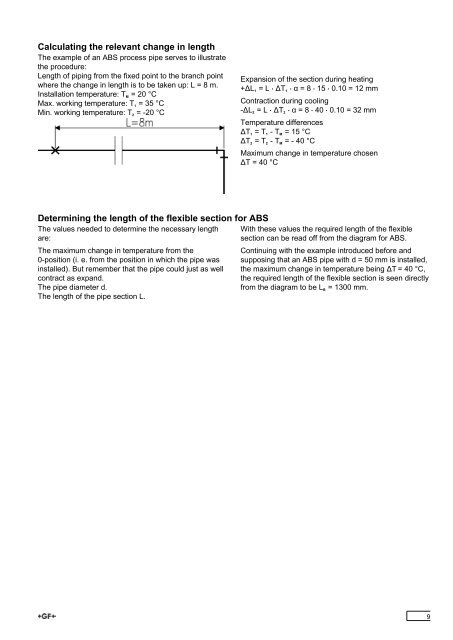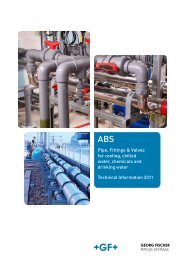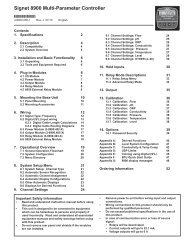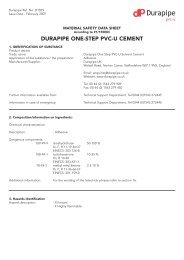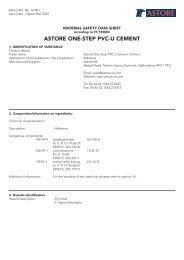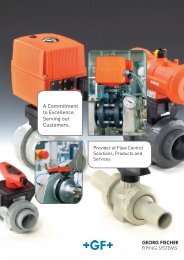- Page 1: SYGEF ® PVDF Pipe, Fittings, Hand
- Page 4 and 5: Materials used for industrial pipe
- Page 6 and 7: Design of industrial piping systems
- Page 8 and 9: Processing and installations Change
- Page 12 and 13: Processing and installations Pipe b
- Page 14 and 15: Pipe brackets for cold insulation (
- Page 16 and 17: Installing closely spaced pipe brac
- Page 18 and 19: Tools required Infrared fusion join
- Page 20 and 21: Jointing technology Fusion jointing
- Page 22 and 23: Jointing technology Fusion jointing
- Page 24 and 25: off the machined surface. Remove an
- Page 26 and 27: Jointing technology Fusion jointing
- Page 28 and 29: Preparation of the fusion joint Mak
- Page 30 and 31: Heating times and minimum wall thic
- Page 32 and 33: Ball check valve silicon free/paint
- Page 34 and 35: Butt Fusion Fittings Bend 90°, PN
- Page 36 and 37: T 90° equal, PN 16, PVDF-Standard
- Page 38 and 39: Flange Adaptor, PN 10, jointing fac
- Page 40 and 41: Union (FPM black), PN 16, PVDF-Stan
- Page 42 and 43: Transition Fittings Butt Fusion Ada
- Page 44 and 45: Socket Fusion Fittings Elbow 90°,
- Page 46 and 47: Flange Adaptor with groove, PN 16,
- Page 48 and 49: Flange Adaptor, PN 16, jointing fac
- Page 50 and 51: Socket equal, PN 16, PVDF-Standard
- Page 52 and 53: O-Ring, FPM black Note: Ï For the
- Page 54 and 55: Adaptor Socket, female thread - Rp,
- Page 56 and 57: SYGEF ® standard Diaphragm valve t
- Page 58 and 59: SYGEF ® standard Diaphragm valve t
- Page 60 and 61:
Spare parts for diaphragm valve typ
- Page 62 and 63:
SYGEF ® standard Ball valve type 5
- Page 64 and 65:
SYGEF ® standard Ball valve type 5
- Page 66 and 67:
SYGEF ® standard Ball valve type 5
- Page 68 and 69:
SYGEF ® standard Ball valve type 5
- Page 70 and 71:
SYGEF ® standard silicone free Bal
- Page 72 and 73:
Multifunctional module (I03) PP-GF
- Page 74 and 75:
Multifunctional module (I07) PP-GF
- Page 76 and 77:
Spare parts for ball valve type 546
- Page 78 and 79:
Ball valves type 343 SYGEF ® stand
- Page 80 and 81:
SYGEF ® standard 3-Way ball valve
- Page 82 and 83:
SYGEF ® standard 3-Way ball valve
- Page 84 and 85:
SYGEF ® standard 3-Way ball valve
- Page 86 and 87:
Spare parts for ball valve type 343
- Page 88 and 89:
Ball check valves SYGEF ® standard
- Page 90 and 91:
Ball check valve silicon free/paint
- Page 92 and 93:
Spare parts for ball check valve ty
- Page 94 and 95:
SYGEF ® standard Butterfly valve t
- Page 96 and 97:
SYGEF ® standard Lugstyle butterfl
- Page 98 and 99:
SYGEF ® standard Lugstyle butterfl
- Page 100 and 101:
SYGEF ® standard Lugstyle butterfl
- Page 102 and 103:
Spare parts for butterfly valve typ
- Page 104 and 105:
SYGEF ® standard Wafer check valve
- Page 106 and 107:
Spare parts for wafer check valve t
- Page 108 and 109:
Pipes Pipe, PN 16, PVDF-HP d [mm] P
- Page 110 and 111:
Elbow 90°, PN 16, PVDF-HP d [mm] P
- Page 112 and 113:
T 90° reduced, PN 16, PVDF-HP d -
- Page 114 and 115:
Flange Adaptor, PN 10, jointing fac
- Page 116 and 117:
Reducing Bush, eccentric, PN 16, PV
- Page 118 and 119:
Instrument Installation Fitting, PN
- Page 120 and 121:
Transition Fittings Adaptor Nipple,
- Page 122 and 123:
Sanitary Adaptors Sanitary Adaptor,
- Page 124 and 125:
Sanitary Adaptor, PN16, PVDF-HP, wi
- Page 126 and 127:
SYGEF ® PLUS Diaphragm valve type
- Page 128 and 129:
SYGEF ® PLUS Diaphragm valve type
- Page 130 and 131:
SYGEF ® PLUS Diaphragm valve type
- Page 132 and 133:
d [mm] Lift = Hx [mm] D2 [mm] H [mm
- Page 134 and 135:
d [mm] Lift = Hx [mm] D2 [mm] H [mm
- Page 136 and 137:
Pipe Pipe, PVDF (Exhaust) d [mm] Co
- Page 138 and 139:
Socket equal, PVDF (Exhaust) Model:
- Page 140 and 141:
Flanges Fix Flange, PVDF (Exhaust)
- Page 142 and 143:
Welding Rods Welding Rod Ï Extrude
- Page 144 and 145:
142
- Page 146 and 147:
Backing Flange, PP-V Backing Flange
- Page 148 and 149:
Backing Flanges, PP-V for Butt Fusi
- Page 150 and 151:
Backing Flanges, PP/Steel for Socke
- Page 152 and 153:
Fixed Flange PVDF Fixed Flanges, so
- Page 154 and 155:
Flange Gaskets for Flange Connectio
- Page 156 and 157:
Flat Gaskets Model: Ï Silicon-free
- Page 158 and 159:
KLIP-IT Pipe Clips Type 061, PE met
- Page 160 and 161:
158
- Page 162 and 163:
IR-63 Plus ® Fusion Jointing Machi
- Page 164 and 165:
IR-315 Plus ® Fusion Jointing Mach
- Page 166 and 167:
BCF ® Plus Plastic Fusion Jointing
- Page 168 and 169:
BCF ® Plus basic machine d 20-63 m
- Page 170 and 171:
BCF ® Plus basic machine d 20 -110
- Page 172 and 173:
BCF ® Plus Bladder Ï Only suitabl
- Page 174 and 175:
BCF ® Plus extension cable Ï The
- Page 176 and 177:
Tools Spare Cutting Wheel Ï for pl
- Page 178 and 179:
Code Index Code Page Code Page Code
- Page 180 and 181:
Code Index Code Page Code Page Code
- Page 182 and 183:
Code Index Code Page Code Page Code
- Page 184 and 185:
Code Index Code Page Code Page Code
- Page 186 and 187:
Code Index Code Page Code Page Code
- Page 188 and 189:
GEORGE FISCHER SALES LIMITED (“Ge


